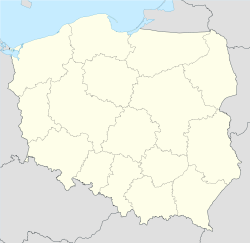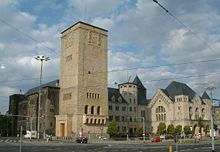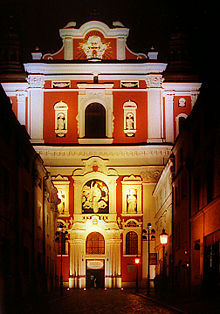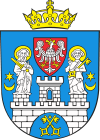Poznań
- See also: Poznań, Lublin Voivodeship
| Poznań | |||
 |
|||
|
|||
 Poznań
|
|||
| Coordinates: | |||
| Country | |||
|---|---|---|---|
| Voivodeship | Greater Poland | ||
| County | city county | ||
| Established | 8th century | ||
| Town rights | 1253 | ||
| Government | |||
| - Mayor | Ryszard Grobelny | ||
| Area | |||
| - City | 261.85 km² (101.1 sq mi) | ||
| Highest elevation | 154 m (505 ft) | ||
| Lowest elevation | 60 m (197 ft) | ||
| Population (2006) | |||
| - City | 566,546 | ||
| - Density | 2,163.6/km² (5,603.8/sq mi) | ||
| - Metro | 855,894 | ||
| Time zone | CET (UTC+1) | ||
| - Summer (DST) | CEST (UTC+2) | ||
| Postal code | 60-001 to 61-890 | ||
| Area code(s) | +48 61 | ||
| Car plates | PO | ||
| Website: http://www.poznan.pl/ | |||
Poznań [ˈpɔznaɲ] (![]() listen) (Latin: Posnania; German: Posen; Yiddish: פּױזן Poyzn) is a city in west-central Poland with over 567,882 inhabitants (2006). Located on the Warta River, it is one of the oldest cities in Poland, making it an important historical centre and a vibrant centre of trade, industry, and education. Poznań is Poland's fifth largest city and fourth biggest industrial centre. It is also the administrative capital of the Greater Poland Voivodeship.
listen) (Latin: Posnania; German: Posen; Yiddish: פּױזן Poyzn) is a city in west-central Poland with over 567,882 inhabitants (2006). Located on the Warta River, it is one of the oldest cities in Poland, making it an important historical centre and a vibrant centre of trade, industry, and education. Poznań is Poland's fifth largest city and fourth biggest industrial centre. It is also the administrative capital of the Greater Poland Voivodeship.
Poznań's cathedral is the oldest in the country, containing the tombs of the first Polish rulers: Duke Mieszko I, King Boleslaus the Brave, King Mieszko II, Duke Casimir I the Restorer, Duke Przemysł I, and King Przemysł II.
Poznań is the host city for the United Nations Climate Change Conference, taking place in December 2008. The conference is a key event in the creation of a successor to the Kyoto Protocol.
Contents |
Etymology
The name Poznań probably comes from a personal name Poznan (from the Polish participle poznan(y)) and would mean "Poznan's town." It is also possible the name comes directly from the verb poznać which means "to get to know" or "to recognize".
The earliest surviving references to the city were by Thietmar in his chronicles: episcopus Poznaniensis ("Bishop of Poznań", 970) and ab urbe Poznani ("by" or "from the city Poznań", 1005). Early spellings include Posna and Posnan, which have also historically been used in English.
The official city name in full is The Capital City of Poznań (Polish: Stołeczne Miasto Poznań). Poznań is known as Posen in German, and was officially known as Haupt- und Residenzstadt Posen ("Capital and Residence City of Poznań") between 20 August 1910, and 28 November 1918. The city has been known in Latin as Posnania and civitas Posnaniensis. Its Yiddish name is פּױזן, or Poyzn.
History

Mieszko I, the first known duke of the Polans, built one of his castles in Poznań. The Cathedral Basilica of St. Peter and St. Paul is the oldest Polish cathedral, founded in Poznań during the latter half of the 10th century. The city would become the capital of Greater Poland. Mieszko I's son, Boleslaus the Brave, was crowned king in 1025 and the Kingdom of Poland was formed. Greater Poland became the 'cradle of the Polish state', and both Mieszko I and Boleslaus I are buried in Poznań. Lubrański Academy, the second Polish university (not a "full" university, in fact, as science students had to go to Kraków) was established in 1519.
Poznań was the capital of the Greater Poland area when it came under the control of Prussia in 1793 and had its administrative area renamed to South Prussia. During the Greater Poland Uprising of 1806, local Polish resistance fighters rebelled, thereby assisting the efforts of Napoleon while simultaneously driving out the occupying Prussian forces. The city became part of the Duchy of Warsaw in 1807 and was capital of the Poznań Department. Napoleon's defeat led to the Congress of Vienna, where the boundaries of Europe were redrawn by the victors. Greater Poland was returned to Prussia and became the capital of the autonomous Grand Duchy of Posen. From the time of the Revolutions of 1848, Poznań was the capital of the Prussian Province of Posen. It became part of the German Empire during the unification of German states in 1871.

Shortly after Imperial Germany's defeat in World War I, the Great Poland Uprising (1918-1919) occurred, leading to the creation of the Second Polish Republic, in which Poznań became the capital of Poznań Voivodeship. During World War II, Poland suffered under Nazi occupation and the Polish population was severely repressed. In 1945, the city was declared a Festung (a fortified locale in which German forces were expected to conduct a last-ditch defense) by order of Hitler. As Poznań lay on the direct route from Warsaw to Berlin, the Red Army first besieged and then assaulted the German defenses, culminating in the assault on the Cytadela (citadelle) and resulting in serious damage to the city. Since the war's end, Poznań has been the capital of the surrounding area through administrative district boundary changes in 1957, 1975, and 1999; Poznań currently administrates Greater Poland Voivodeship, one of 16 provinces in the country.
Anti-communist protests in 1956 played a significant role in liberalising the post-war communist regime.
- Further information: History of Poland










Historical population
Detailed demographic tables: Historical population of Poznań
Historical population summary:
- 1600 : about 20,000 inhabitants
- 1732 : 4000 inhabitants
- 1793 : 15,000 inhabitants before
- 1918 : 156,091 inhabitants (from government data)
- 1939 : 274,155 inhabitants
- 1946 : 268,000 inhabitants
- 2000 : 572,900 inhabitants
- May 2002: 578,900 inhabitants
2020 population Forecast:
- Poznań City 584,500 (small increase)
- Poznań County 305,500 (significant increase)
- Poznań Metro Area 890,000
Geography
- City area 261.3 km2 (100.9 sq mi) (2002)
- Geographical location:
- 52°17'34''N - 52°30'27''N
- 16°44'08''E - 17°04'28''E
- Highest point: Mt. Morasko 157 m (515 ft) asl
- Lowest point: Warta river valley: 60 m (197 ft) asl
Administrative division
The Poznań metropolitan area, consisting of the autonomous towns of Poznań, Ostrów, Ostrówek, Środka, Chwaliszewo, Łacina, was integrated into one city from 1793–1800. The rapidly growing city annexed the neighboring villages of Grunwald, Łazarz, Górczyn, Jeżyce, Wilda, Winogrady in 1900, Piątkowo and Rataje in later years. Today, Poznań is divided into five districts, which are further divided onto several dozens of neighborhoods. The districts are:
- Stare Miasto
- Nowe Miasto
- Jeżyce
- Grunwald
- Wilda
Economy
Poznań has been an important center of trade since the Middle Ages. Starting in the 19th century, local heavy industry began to grow. Several major factories were built, including the steel mill and railway factory of Hipolit Cegielski (see H. Cegielski - Poznań S.A.).
Today Poznań is one of the major centers of trade with Germany. Many Western European companies started their Polish branches in Poznań, or in the nearby localities of Tarnowo Podgórne and Swarzędz. It is the site of annual Poznań International Fair.
Most foreign investors are German and Dutch companies (see "Major corporations" above), with a few others. Investors are mostly from the food processing, furniture, automotive and transport & logistics industries. Foreign companies are primarily attracted by low labour costs, but also by the relatively good road and railway network, good vocational skills of workers and relatively liberal employment laws. As compared with Germany, there are far fewer restrictions, e.g. on shop opening hours.
For a list of major Poznań-based corporations see Major corporations in Poznań
Culture
The annual Malta Theater festival is probably the most characteristic cultural event of the city. There are also Henryk Wieniawski Violin Competition (held every 5 years), and Classical Music Festival (annual).
Education
Poznań is home to a few state-owned universities and a number of smaller, mostly private-run colleges and institutions of higher education. Adam Mickiewicz University (abbreviated UAM) is one of the most influential and biggest universities in Poland:
- Academy of Fine Arts in Poznań
- Academy of Music in Poznań
- Adam Mickiewicz University
- Poznań University of Economics
- Poznań University of Medical Sciences
- Poznań University of Technology
- Poznań University School of Physical Education
- University of Life Sciences in Poznań
Scientific and regional organizations
- Poznań Society of Friends of Arts and Sciences
- Western Institute
Sports
- AZS AWF Poznań - women's volleyball team playing in Polish Seria A Women's Volleyball League: 8th place in 2003/2004 season.
- AZS Poznań - women's basketball team playing in Torell Basket Liga: 2nd place in 2003/2004 season (formerly also called Danter AZS Poznań and Stary Browar AZS Poznań)
- KKS Lech Poznań - men's football team (Polish Champion: 1983, 1984, 1990, 1992, 1993 ; Polish Cup winner 1982, 1984, 1988, 2004 ; Polish SuperCup winner 1990, 1992, 2004)
- KS AZS AWF Poznań - men's field hockey team
- KS Energetyk - rhythmic gymnastics club
- KS Pocztowiec Poznań - men's field hockey team
- KTKFiT Błękitny Express Lech Poznań - men's field hockey team
- Lake Malta in Poznań will host the World Rowing Championships in 2009 and has previously hosted some regattas in the Rowing World Cup.
- MKS Dąbrówka - rhythmic gymnastics club, synchronized swimming
- Polonia Poznań - men's football team
- PSŻ Poznań - motorcycle speedway team
- SSW Malta Poznań - roller skating club
- TPS Winogrady Poznań - men's football team
- UKS Szóstka - synchronized swimming, football
- UKS Wanda - synchronized swimming
- U-19 EURO CHAMP. in VI 2006 - [man's Football European Cup 19 year] - Open and Final.
- Warta Poznań - men's football team (Polish Champion: 1929, 1947), (2nd league in season 2007/2008).
- WKS Grunwald Poznań - sports club with sections in field hockey, shooting, wrestling, handball and tennis.
Politics
Municipal politics
Since the end of the communist era in 1989, Poznań municipality and metro area have invested heavily in infrastructure, especially public transportation and improved administration. This has resulted in a massive investment from foreign companies in Poznań itself, as well as in communities west and south of Poznań (namely, Kórnik and Tarnowo Podgórne). Worth noticing is the positive attitude of public administration towards investments, and less annoying "red tape" than elsewhere in Poland.
City investment into transportation was mostly in the public transport area. While the number of cars since 1989 has at least doubled, the policy of improving public transport gave good effects. Limiting car access to the city center, building new tram lines (inc. Poznański Szybki Tramwaj) and investing in new rolling stock (such as modern Combino trams by Siemens and Solaris low-floor buses) actually increased the level of ridership. This is a notable success, even considering the fact that Polish society only possesses about half of the "old EU"'s purchasing power, hence not everybody can afford to own a car.
Future investments into transportation include the construction of a "third ring road" around the city, and the completion of A2 (E30) highway towards Berlin. In the public transport area (and non-car transportation), further investment must be made into the development bicycle paths (and the linking of presently existing ones), and an attempt is presently made of developing Karlsruhe-style light rail system for commuters. All that is made more complicated (and more expensive) by the heavy neglect of transportation throughout communist era.
- See also: Tramways in Poznań
Constituency
Members of Sejm elected in 2005 from Poznań constituency:
- Arkady Radosław Fiedler, PO
- Waldy Dzikowski, PO
- Maria Pasło-Wiśniewska, PO
- Dariusz Lipiński, PO
- Michał Stuligrosz,PO
- Tomasz Górski, PiS
- Jan Filip Libicki, PiS
- Małgorzata Stryjska, PiS
- Jacek Tomczak, PiS
- Krystyna Łybacka, SLD
Members of European Parliament elected from Poznań constituency:
- Filip Kaczmarek, PO
- Jan Kułakowski, Unia Wolności
- Marcin Libicki, PiS
- Jan Masiel, Samoobrona
- Marek Siwiec, SLD
- Witold Tomczak, LPR
Notable residents
- Anna Anderson (c. 1900 - 1984), pretender of Grand Duchess Anastasia of Russia
- Lothar von Arnauld de la Perière (1886 - 1941), German U-boat commander
- Isidor Ascheim (1891-1968), painter and printmaker
- Stanisław Barańczak (born 1946), poet
- Herbert Baum (1912 – 1942) resistance fighter
- Zygmunt Bauman (born 1925), sociologist
- Bernhard Baumeister (1828-1917), actor
- Józef Brzeziński, biologist
- Brigitte Burmeister (died 1940), novelist
- Heinrich Caro (1834-1910), chemist
- Hipolit Cegielski (1815-1868), businessman
- Dezydery Chłapowski (1788-1848), general
- August Cieszkowski (1814-1894), philosopher
- Antoni Czubiński (1928-2003), historian
- Leopold Damrosch (1832 – 1885), conductor
- Ludwig Dessoir, (1810 - 1874), actor
- Franciszek Dobrowolski (1830-1896), theater director
- Tytus Działyński (1796-1861), political activist
- Małgorzata Dydek (born 1974), basketball player
- Akiva Eiger (1761-1837), Rabbi of Poznań (1815-1837)
- Jean Paul Ertel (1865-1933), composer
- Ewaryst Estkowski (1820-1856), teacher
- Fredrak Fraske (1872-1973), the last surviving United States veteran of the Indian Wars
- Jean Gebser (1905-1973), human consciousness scientist
- Eduard Gerhard (1795 - 1867), archaeologist
- Friedrich Goltz (1834 - 1902), physiologist
- Konstanty Gorski (1859-1924), composer and violinist
- Paul von Hindenburg (1847-1934), Field Marshal and President of the Weimar Republic
- Maksymilian Jackowski (1815-1905), activist
- John Jonston (1603-1675), naturalist and physician
- Stefan Jurga (born 1946), professor and rector of Adam Mickiewicz University in Poznań (1996-2002)
- Jan A.P. Kaczmarek (born 1954), composer
- Richard Kandt (1867-1918), doctor and explorer
- Ernst Hartwig Kantorowicz (1895-1963), historian
- Marek Karpinski, computer scientist
- Günther von Kluge (1882-1944), Field Marshal
- Krzysztof Komeda (1931-1969), jazz musician
- Leo Königsberger (1837-1921), mathematician
- Antoni Kraszewski (1797-1870), politician
- Max Kretzer (1854-1941), writer
- Antoni Krzyżanowski, 19th century architect
- Gerard Labuda (born 1916), historian
- Arthur Liebehenschel (1901 - 1948), commandant of Auschwitz and Majdanek
- Paul Leonhardt (1877-1934), chess master
- Karol Libelt (1807-1875), philosopher
- Włodzimierz Łęcki (born 1937), politician and writer
- Andrzej Maleszka (born 1955), theatre and movie director
- Karol Marcinkowski (1800-1848), physician and social activist
- Władysław Markiewicz (born 1920), sociologist
- Teofil Matecki (1810-1886), philosopher
- Heinrich Mendelssohn (1881-1959), building tycoon
- Karl-Friedrich Merten (1905 - 1993), U-boat commander
- Maciej Mielżyński (1799-1870), politician
- Julius Moses (1868-1942), politician
- Małgorzata Musierowicz (born 1945), novelist
- Andrzej Niegolewski (1787-1857), colonel
- Władysław Niegolewski (1814-1880), politician
- Gustav Oelsner (1879-1956), architect
- Władysław Oleszczyński (1809-1866), sculptor
- Lilli Palmer (1914-1986), actress
- Janusz Pałubicki (born 1948), politician
- Kazimierz Piwarski, (1903-1968), historian
- Gustaw Potworowski (1800-1860), activist
- Tomasz Przybecki (born 1981), articled clerk
- Edward Raczyński (1786-1845), politician
- Cyryl Ratajski (1875-1942), mayor of Poznań
- Antoni Radziwiłł (1775-1833), aristocrat
- Marian Rejewski (1923-1929), cryptoanalist, Enigma codemachine codebreaker
- Richard Rothe ( 1799 - 1867), Lutheran theologian.
- Jerzy Różycki (1927-1932), cryptoanalist, Enigma codemachine codebreaker
- Michał Sczaniecki (1910-1977), historian
- Józef Struś (1510-1568), scientist and mayor of Poznań
- Sir Paweł Edmund Strzelecki (July 20, 1797 - October 6, 1873), Polish explorer and geologist
- Tiago Ferreira (born 1979), accountant
- Stefan Stuligrosz (born 1920), choral conductor
- Rafał Szukała (born 1971), butterfly swimmer
- Roman Szymański (1840-1908), political activist
- Mirosław Szymkowiak (born 1976) football player
- Jerzy Topolski (1928-1998), historian
- Lech Trzeciakowski (born 1931), historian
- Jan Węglarz (born 1947), computer scientist
- Piotr Wiśniewski (born 1955), Statistician
- Zygmunt Wojciechowski, (1900-1955), historian and founder of the Western Institute
- Leon Wegner (1824-1873), economist
- Anna Wolff-Powęska, historian
- Henryk Zygalski (1906-1978), cryptoanalist, Enigma codemachine codebreaker
Twin towns
Poznań is twinned with:[1]
|
|
Footnotes
- ↑ "Poznań Official Website - Twin Towns".
 (in Polish) © 1998-2008 Urząd Miasta Poznania. Retrieved on 2008-11-29.
(in Polish) © 1998-2008 Urząd Miasta Poznania. Retrieved on 2008-11-29.
Bibliography
- collective work, Poznań. Dzieje, ludzie kultura, Poznań 1953
- Robert Alvis, Religion and the Rise of Nationalism: A Profile of an East-Central European City, Syracuse University Press, Syracuse 2005
- K. Malinowski (red.), Dziesięć wieków Poznania, t.1, Dzieje społeczno-gospodarcze, Poznań 1956
- collective work, Poznań, Poznań 1958
- collective work, Poznań. Zarys historii, Poznań 1963
- Cz. Łuczak, Życie społeczno-gospodarcze w Poznaniu 1815-1918, Poznań 1965
- J. Topolski (red.), Poznań. Zarys dziejów, Poznań 1973
- Zygmunt Boras, Książęta Piastowscy Wielkopolski, Wydawnictwo Poznańskie, Poznań 1983
- Jerzy Topolski (red.), Dzieje Poznania,Wydawnictwo PWN, Warszawa - Poznań 1988
- Alfred Kaniecki, Dzieje miasta wodą pisane, Wydawnictwo Aquarius, Poznań 1993
- Witold Maisel (red.), Przywileje miasta Poznania XIII-XVIII wieku. Privilegia civitatis Posnaniensis saeculorum XIII-XVIII. Władze Miasta Poznania, Poznańskie Towarzystwo Przyjaciół Nauk, Wydawnictwa Żródłowe Komisji Historycznej, Tom XXIV, Wydawnictwo PTPN, Poznań 1994
- Wojciech Stankowski, Wielkopolska, Wydawnictwo WSiP, Warszawa 1999
- Gotthold Rhode : Geschichte der Stadt Posen
See also
- Bambrzy
- History of Poland
- Major corporations in Poznań
- Poznań Department, a unit of administrative division and local government in the Duchy of Warsaw from 1806 to 1815.
- Royal coronations in Poznań cathedral
External links
- Poznań at the Open Directory Project
- Poznań Multimedia City Guide - Official Municipality Site
- Interaktywny Poznań - city guide
|
||||||||||
|
||||||||||||||||||||||||||||||||||||||||||
|
|||||||
|
||||||||||
|
|||||||



